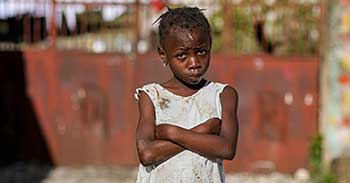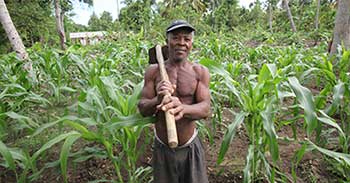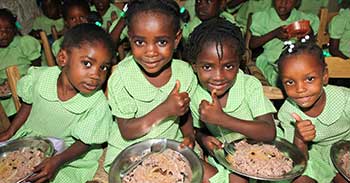A street sign marking the way to Tony's house is the #26 hanging on the tree.
My brain is so confused. Since it’s dark out, I guess it’s nighttime, although in my weary mind, maybe it’s tomorrow night.
I can’t keep track of the time of day, let alone the day of the week. It’s hard to remember that it’s February and that it should be cold outside.
The only thing I know for sure is which way is up. That’s good because I know which direction to send my prayers and there are many.
I thank God for putting Barry Borror in my life under whose wonderful care I am in.
I also thank our host, Tony, for welcoming us into his home and being so gracious in answering our countless questions about his country. It must be exhausting.
I also thank God for giving Tony an impeccable sense of direction. The man is better than any GPS system on the planet.
To say that traveling in Haiti is difficult is putting it mildly; traveling in Port-au-Prince is impossible for visitors and dangerous even for the locals. There are places Tony is hesitant to take us, like the open-air market, and places he refuses to take us like City Sole.
The main problem with traveling as I see it is the absence of street signs, traffic signs and trafficable streets and roads.
When I think of the decisions I help make concerning the Barton County roads, it’s almost laughable by comparison to what the Haitians deal with. (BTW, I thank God for the great roads we have in the U.S. and the small problems I face on the commission.)
There are only two paved highways in Haiti and depending on your perspective, they either take you into or out of Port-au-Prince. I use the term paved quite loosely here. They are partially paved – maybe the whole width, maybe half, maybe less. Pot holes (big enough to lose a small car) and speed bumps (large enough to high center a small car), appear randomly.
Tony, as well as other Haitian drivers, drive on the right side or left side of the road depending on where the holes and bumps are.
As an aside, there appears to be no road rage in Haiti. People tail gate, cut off others, whip in and out of traffic, pass as other cars approach head on and a myriad of other driving transgressions without animosity. Near collisions – within the half-inch mark – are so common that even I stopped noticing. I guess when in Haiti … applies.
To get back on course, Haitian roads leave A LOT to be desired. This lack of infrastructure limits the country’s ability to improve, maintain or grow in any meaningful way. I am not exaggerating by saying the roads look as if they have been bombed. I don’t think they could be any worse in a war zone.
Roads into towns off the main highways are not clearly (if at all) marked by any standard. Making a U-turn off of a highway onto a secondary road finds a plethora of other problems. Roads are dusty or muddy depending on the day and so dangerously narrow that if two cars meet, one must back up. (Tony tells us the biggest vehicle always has the right of way and always wins.)
Roads are also pot holed, filled with rocks and have things like muddy streams to cross and animals – including goats, cows, donkeys and small children walking to school – to avoid. Kansas deer and raccoons would be proud of their Haitian counterparts because they are rarely, if ever, hit.
Add to that the huge problem of trash and debris as well as building materials dumped in front of the home/building where it is to be used some day and you begin to get the picture.
Today’s trip to the mountain town of Dano is likely to leave us with sore muscles. We braced our legs and held onto our bobble heads as best we could, but still felt like popcorn in a sizzling skillet.
Tony’s home where we are staying is on the outskirts of Port-au-Prince although for all I know it’s in Timbuktu. A main street in the city’s capital is more like one of our alleys, although not as well maintained. Signs for smaller streets are hand painted on fences or trees or often non-existent.
The added difficulty is that you can’t see where you are going because every property is well guarded with a concrete block wall. The narrow streets, bordered by trees and fences, give one the impression of being a mouse in a maze. The streets continue to get narrower and narrower until the road leads us to our home away from home.
And for that, I truly thank God.











